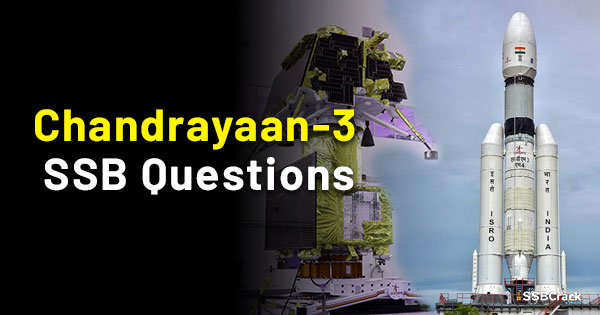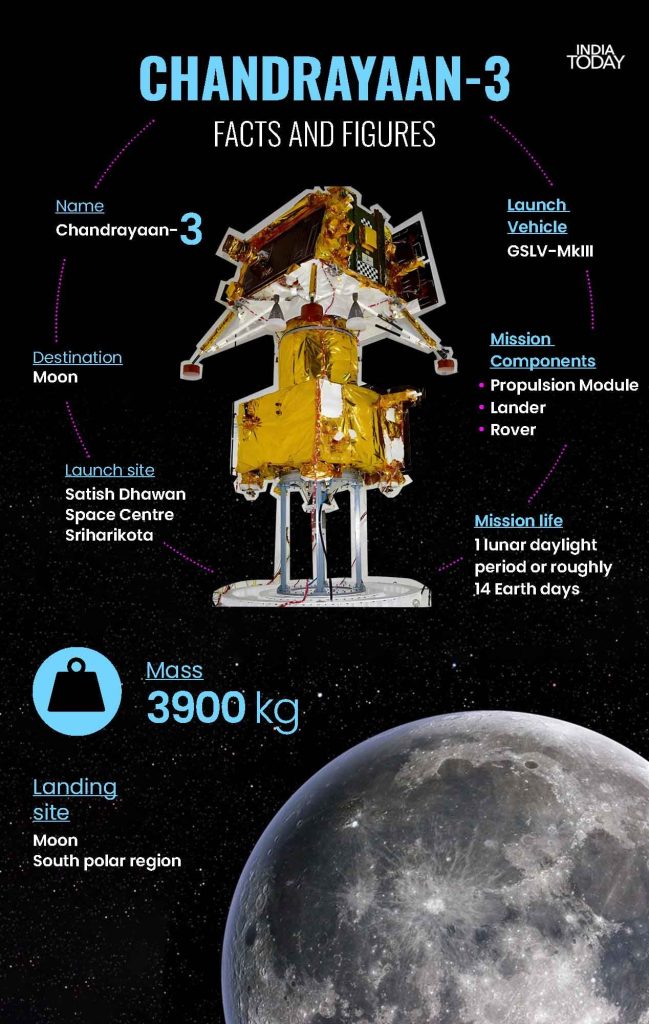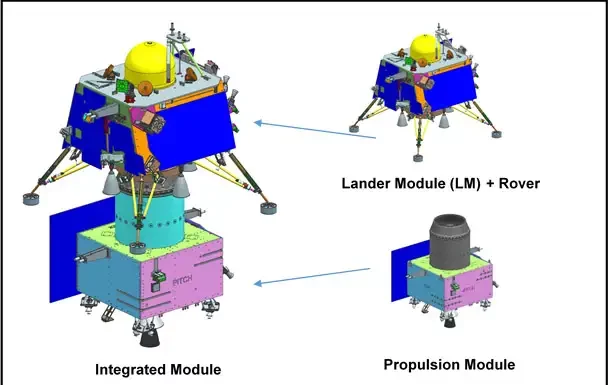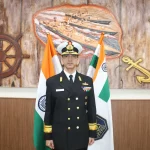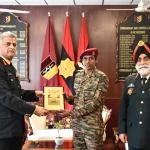It is possible to ask questions related to ISRO’s Chandrayaan-3 mission in an SSB (Services Selection Board) interview. The SSB interview is conducted for the selection of candidates for various officer-level positions in the Indian Armed Forces. The interview aims to assess the candidate’s personality, knowledge, and suitability for a career in the armed forces.
Chandrayaan-3 Updates:
Departing from the Satish Dhawan Space Center in Sriharikota, the Chandrayaan-3 mission by the Indian Space Research Organisation (ISRO) has achieved a successful lunar landing after a 40-day voyage. The Vikram lander touched down on the Moon’s surface at 6.04 PM IST on August 23.
Currently, ISRO is diligently tracking the condition of all systems within the mission. The Pragyan rover is anticipated to begin its operations in the imminent hours.
Chandrayaan-3 is the successor to the 2019’s Chandrayaan-2 mission, during which the Vikram lander unfortunately impacted the lunar terrain. The central aim of this mission is clear-cut: demonstrate ISRO’s proficiency in achieving a lunar soft landing. With this accomplishment, India proudly stands alongside an elite trio of nations— the United States, the Soviet Union, and China— that have achieved this feat.
During the Chandrayaan-3 mission’s climactic moments, the following four stages transpired, often referred to as the “15 minutes of terror,” leading up to its triumphant soft landing on the Moon:
- Rough Braking Phase: In this stage, the lander’s horizontal speed was diminished from a staggering 6,000 kilometres per hour to almost a standstill, setting the stage for a gentle landing.
- Attitude Holding Phase: As the lander hovered approximately 7.43 kilometres above the Moon’s crust, it transitioned from a horizontal alignment to a vertical stance, all while traversing a span of 3.48 kilometres.
- Fine Braking Phase: Spanning around 175 seconds, the lander shifted roughly 28.52 kilometres across the lunar expanse to its designated landing spot, concurrently descending its altitude by about 1 kilometre. It’s noteworthy that Chandrayaan-2 faced challenges between the Attitude Holding and Fine Braking phases.
- Terminal Descent: Marking the mission’s culmination, the vertically-aligned lander undertook its final descent, alighting gracefully upon the lunar terrain.
Since space technology and scientific advancements are relevant areas for defense and national security, questions related to space missions, including Chandrayaan-3, may be asked to assess the candidate’s awareness, general knowledge, and scientific aptitude. It is always advisable to stay updated on current affairs, technological advancements, and space missions, including those by ISRO, to prepare for such questions in an SSB interview.
What is Chandrayaan-3
Chandrayaan-3 is the next mission after Chandrayaan-2, aiming to showcase the complete ability to safely land and navigate on the lunar surface. The mission comprises a Lander and Rover configuration and will be launched from SDSC SHAR, Sriharikota, using LVM3. The propulsion module will transport the Lander and Rover to a lunar orbit of 100 km. The propulsion module is equipped with the Spectro-polarimetry of Habitable Planet Earth (SHAPE) payload, which is designed to study Earth’s spectral and polarimetric measurements from the lunar orbit.
Chandrayaan-3 SSB Interview Questions
Question 1: What is the objective of Chandrayaan-3?
Answer: The objective of Chandrayaan-3 is to demonstrate safe and soft landing on the lunar surface, conduct rover roving on the Moon, and perform in-situ scientific experiments.
Question 2: What are the payloads carried by the lander in Chandrayaan-3?
Answer: The lander in Chandrayaan-3 carries the following payloads:
- Chandra’s Surface Thermophysical Experiment (ChaSTE) for measuring thermal conductivity and temperature.
- Instrument for Lunar Seismic Activity (ILSA) for measuring lunar seismicity.
- Langmuir Probe (LP) to estimate plasma density variations.
- Laser Retroreflector Array (LRA) from NASA for lunar laser ranging studies.
Question 3: What are the payloads carried by the rover in Chandrayaan-3?
Answer: The rover in Chandrayaan-3 carries the following payloads:
- Alpha Particle X-ray Spectrometer (APXS) for deriving elemental composition.
- Laser Induced Breakdown Spectroscope (LIBS) for elemental analysis and mineralogical composition determination.
Question 4: What is the propulsion module in Chandrayaan-3 responsible for?
Answer: The propulsion module in Chandrayaan-3 is responsible for carrying the lander and rover configuration from launch vehicle injection to a lunar orbit of 100 km. It also carries the Spectro-polarimetry of Habitable Planet Earth (SHAPE) payload to study Earth from the lunar orbit.
Question 5: What are some of the advanced technologies present in the lander of Chandrayaan-3?
Answer: Some of the advanced technologies present in the lander of Chandrayaan-3 include altimeters (laser and RF-based), velocimeters (laser Doppler velocimeter and lander horizontal velocity camera), inertial measurement systems (laser gyro-based inertial referencing and accelerometer package), propulsion systems (throttleable liquid engines), navigation, guidance, and control systems (powered descent trajectory design and associated software elements), and hazard detection and avoidance systems (lander hazard detection and avoidance camera and processing algorithm).
Question 6: What are the touchdown specifications for the lander in Chandrayaan-3?
Answer: The touchdown specifications for the lander in Chandrayaan-3 are as follows:
- Vertical velocity: ≤ 2 m / sec
- Horizontal velocity: ≤ 0.5 m / sec
- Slope: ≤ 120°
Question 7: What is the identified launcher for Chandrayaan-3?
Answer: The identified launcher for Chandrayaan-3 is GSLV-Mk3.
Question 8: What are the power generation capabilities of the propulsion module, lander module, and rover in Chandrayaan-3?
Answer: The power generation capabilities are as follows:
- Propulsion Module: 758 W
- Lander Module: 738 W (with bias)
- Rover: 50 W
Question 9: How long is the mission life of the lander and rover in Chandrayaan-3?
Answer: The mission life of the lander and rover in Chandrayaan-3 is approximately one lunar day, which is equivalent to about 14 Earth days.
Question 10: What communication systems are used in Chandrayaan-3?
Answer: In Chandrayaan-3, the propulsion module communicates with the IDSN (Indian Deep Space Network), the lander module communicates with the IDSN and the rover, and there is also a contingency link planned with the Chandrayaan-2 Orbiter.
Question 11: What are the scientific payloads carried by the lander module and rover in Chandrayaan-3?
Answer: The scientific payloads carried by the lander module are Radio Anatomy of Moon Bound Hypersensitive ionosphere and Atmosphere (RAMBHA), Chandra’s Surface Thermophysical Experiment (ChaSTE), Instrument for Lunar Seismic Activity (ILSA), and Laser Retroreflector Array (LRA). The rover carries the Laser Induced Breakdown Spectroscope (LIBS) and Alpha Particle X-ray Spectrometer (APXS).
Question 12: What is the objective of the Spectro-polarimetry of Habitable Planet Earth (SHAPE) payload in Chandrayaan-3?
Answer: The objective of the SHAPE payload in Chandrayaan-3 is to study the spectral and polarimetric measurements of Earth from the lunar orbit, which can contribute to future discoveries and understanding of habitable exoplanets.
Question 13: How is the plasma density near the lunar surface measured in Chandrayaan-3?
Answer: The plasma density near the lunar surface is measured using a Langmuir Probe (LP) carried by the lander module in Chandrayaan-3.
Question 14: What is the purpose of the Laser Inertial Referencing and Accelerometer Package (LIRAP) in the lander of Chandrayaan-3?
Answer: The purpose of the Laser Inertial Referencing and Accelerometer Package (LIRAP) in the lander of Chandrayaan-3 is to provide precise navigation and acceleration measurements during the mission.
Question 15: What is the mass of the propulsion module, lander module, and rover in Chandrayaan-3?
Answer: The mass of the propulsion module is 2148 kg, the lander module is 1752 kg (including the rover of 26 kg), and the total mass is 3900 kg.
Question 16: Why Chandrayaan-2 Failed?
Answer: Chandrayaan 2 failed because the Vikram lander couldn’t control its speed and tumbled down.
Question 17: Why is Chandrayan 3 exploring the Moon’s south pole?
Answer: One primary objective of the mission is to search for water-ice. Researchers believe this could pave the way for future human settlement on the Moon. Additionally, it has the potential to provide fuel for spacecraft traveling to Mars and beyond.
Specifications for Chandrayaan-3
| Sl No. | Parameter | Specifications |
|---|---|---|
| 1. | Mission Life (Lander & Rover) | One lunar day (~14 Earth days) |
| 2. | Landing Site (Prime) | 4 km x 2.4 km 69.367621 S, 32.348126 E |
| 3. | Science Payloads | Lander:Radio Anatomy of Moon Bound Hypersensitive ionosphere and Atmosphere (RAMBHA)Chandra’s Surface Thermo physical Experiment (ChaSTE)Instrument for Lunar Seismic Activity (ILSA)Laser Retroreflector Array (LRA) Rover:Alpha Particle X-Ray Spectrometer (APXS)Laser Induced Breakdown Spectroscope (LIBS) Propulsion Module:Spectro-polarimetry of HAbitable Planet Earth (SHAPE) |
| 4. | Two Module Configuration | Propulsion Module (Carries Lander from launch injection to Lunar orbit)Lander Module (Rover is accommodated inside the Lander) |
| 5. | Mass | Propulsion Module: 2148 kgLander Module: 1752 kg including Rover of 26 kgTotal: 3900 kg |
| 6. | Power generation | Propulsion Module: 758 WLander Module: 738W, WS with BiasRover: 50W |
| 7. | Communication | Propulsion Module: Communicates with IDSNLander Module: Communicates with IDSN and Rover. Chandrayaan-2 Orbiter is also planned for contingency link.Rover: Communicates only with Lander. |
| 8. | Lander Sensors | Laser Inertial Referencing and Accelerometer Package (LIRAP)Ka-Band Altimeter (KaRA)Lander Position Detection Camera (LPDC)LHDAC (Lander Hazard Detection & Avoidance Camera)Laser Altimeter (LASA)Laser Doppler Velocimeter (LDV)Lander Horizontal Velocity Camera (LHVC)Micro Star sensorInclinometer & Touchdown sensors |
| 9. | Lander Actuators | Reaction wheels – 4 nos (10 Nms & 0.1 Nm) |
| 10. | Lander Propulsion System | Bi-Propellant Propulsion System (MMH + MON3), 4 nos. of 800 N Throttleable engines & 8 nos. of 58 N; Throttleable Engine Control Electronics |
| 11. | Lander Mechanisms | Lander legRover Ramp (Primary & Secondary)RoverILSA, Rambha & Chaste PayloadsUmbilical connector Protection Mechanism,X- Band Antenna |
| 12. | Lander Touchdown specifications | Vertical velocity: ≤ 2 m / secHorizontal velocity: ≤ 0.5 m / secSlope: ≤ 120 |
The objectives of scientific payloads planned on Chandrayaan-3 Lander Module and Rover are provided below:
| Sl. No | Lander Payloads | Objectives | |
|---|---|---|---|
| 1. | Radio Anatomy of Moon Bound Hypersensitive ionosphere and Atmosphere (RAMBHA) | Langmuir probe (LP) | To measure the near surface plasma (ions and electrons) density and its changes with time |
| 2. | Chandra’s Surface Thermo physical Experiment (ChaSTE) | To carry out the measurements of thermal properties of lunar surface near polar region. | |
| 3. | Instrument for Lunar Seismic Activity (ILSA) | To measure seismicity around the landing site and delineating the structure of the lunar crust and mantle. | |
| 4. | LASER Retroreflector Array (LRA) | It is a passive experiment to understand the dynamics of Moon system. | |
| Sl. No | Rover Payloads | Objectives |
|---|---|---|
| 1. | LASER Induced Breakdown Spectroscope (LIBS) | Qualitative and quantitative elemental analysis & To derive the chemical Composition and infer mineralogical composition to further our understanding of Lunar-surface. |
| 2. | Alpha Particle X-ray Spectrometer (APXS) | To determine the elemental composition (Mg, Al, Si, K, Ca,Ti, Fe) of Lunar soil and rocks around the lunar landing site. |
| Sl. No | Propulsion Module Payload | Objectives |
|---|---|---|
| 1. | Spectro-polarimetry of HAbitable Planet Earth (SHAPE) | Future discoveries of smaller planets in reflected light would allow us to probe into variety of Exo-planets which would qualify for habitability (or for presence of life). |

